Garden of Eden

The Garden of Eden (Hebrew גַּן עֵדֶן, Gan Eden; Arabic: جنة عدن, Jannat ‘Adn)[1] is described in the Book of Genesis as being the place where the first man, Adam, and his wife, Eve, lived after they were created by God. Literally, the Bible speaks about a garden in Eden (Gen. 2:8). This garden forms part of the Genesis creation narrative and theodicy of the Abrahamic religions, often being used to explain the origin of sin and mankind's wrongdoings. The Archangel Uriel, with his flaming sword, is said to be guarding the Gate to the Garden of Eden.
The Genesis creation narrative relates the geographical location of both Eden and the garden to four rivers (Pishon, Gihon, Tigris, Euphrates), and three regions (Havilah, Assyria, and Kush).[2] There are hypotheses that place Eden at the headwaters of the Tigris and Euphrates (northern Mesopotamia), in Iraq (Mesopotamia), Africa, and the Persian Gulf. For many medieval writers, the image of the Garden of Eden also creates a location for human love and sexuality, often associated with the classic and medieval trope of the locus amoenus.[3]
Contents |
Etymology
The origin of the Hebrew עדן, which it translates to "delight", may derive from the Sumerian term EDIN.[4] The Sumerian term means steppe, plain, desert or wilderness,[5] so the connection between the words may be coincidental. This word is known to have been used by the Sumerians to refer to the arid lands west of the Euphrates. Alan Millard has put forward a case for the name deriving from the Semitic stem dn, meaning "abundant, lush".
The story from Genesis
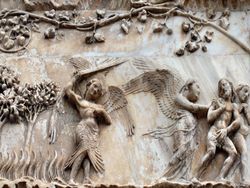
God charges Adam to tend the garden in which they live, and specifically commands Adam not to eat from the Tree of Knowledge of Good and Evil. Eve is quizzed by the serpent concerning why she avoids eating off this tree. In the dialogue between the two, Eve elaborates on the commandment not to eat of its fruit. She says that even if she touches the fruit she will die. The serpent responds that she will not die, rather she and her husband would "be as gods, knowing good and evil," and persuades Eve to eat from the Tree of Knowledge of Good and Evil. Eve eats and gives the fruit to Adam, who also eats. At this point the two become aware, "to know good and evil," evidenced by an awareness of their nakedness. God then finds them, confronts them, and judges them for disobeying.
God expels them from Eden, to keep Adam and Eve from also partaking of the Tree of Life. The story says that God placed cherubim with an omnidirectional "flaming sword" to guard against any future entrance into the garden.
In the account, the garden is planted "eastward, in Eden," and accordingly "Eden" properly denotes the larger territory which contains the garden, rather than being the name of the garden itself: it is, thus, the garden located in Eden. The Talmud also states (Brachos 34b) that the Garden is distinct from Eden.
Geography
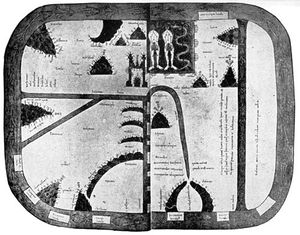
The Book of Genesis gives no location for the Garden, beyond that it is "in Eden, in the East." Internally, it has the form of an enclosed space with a single entrance facing East.
Location
The Biblical description of the garden says :
Now a river flowed out of Eden to water the garden; and from there it divided and became four rivers. The name of the first is Pishon; it flows around the whole land of Havilah, where there is gold.[...] The name of the second river is Gihon; it flows around the whole land of Cush. The name of the third river is Tigris; it flows east of Assyria And the fourth river is the Euphrates.
There have been a number of claims as to the actual geographic location of the Garden of Eden, though many of these have little or no connection to the text of Genesis. Most put the Garden somewhere between Najaf and Kufa in the Middle East.
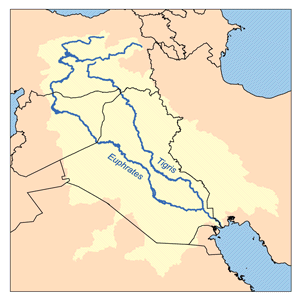
In the Middle East
Sumer and Dilmun
Some of the historians working from within the cultural horizons of southernmost Sumer, where the earliest surviving non-Biblical source of the Biblical account lies, point to the quite genuine Bronze Age entrepôt of the island Dilmun (theorized by some to be Bahrain) in the Middle / Near East, described as 'the place where the sun rises' and 'the Land of the Living'. The setting of the Babylonian creation narrative, Enûma Elish, has clear parallels with the Genesis narratives. After its actual decline, beginning about 1500 BC, Dilmun developed such a reputation as a long-lost garden of exotic perfections that it may have influenced the story of the Garden of Eden. Some interpreters have tried to establish an Edenic garden at the trading-center of Dilmun.
Under the Persian Gulf
The Genesis creation narrative relates the geographical location of both Eden and the garden to four rivers (Pishon, Gihon, Tigris, Euphrates), and three regions (Havilah, Assyria, and Kush). While the Tigris and Euphrates rivers are well known the Pishon and Gihon are not known at all. Gihon is sometimes identified with the Karun River of Iran that flows into the Shott El Arab below Basra. Kush is sometimes associated with Egyptian Kush, but it is also associated with the Kossaei, the homeland of the Kassites (Kashshu), in the Zagros Mountains.[6]
Regarding the Pishon on the location of Eden in Genesis 2:10 says: "And a river went out of Eden to water the garden; and from thence it was parted, and became into four heads. The name of the first is Pison: that is it which compasseth the whole land of Havilah".
Havillah is thought to have been the Arabian shore of the Persian Gulf. Satellite photos of the area shows that before 4,000 BCE there was a river that drained into the Persian gulf at that area, now known as Wadi Ramah and Wadi Batin. Dr. Juris Zarins, the Latvian-American Professor of Southwestern University[7] believes that the Garden of Eden lies in the vacinity, presently under the headwaters of the Persian Gulf, and he further believes that the story of Adam and Eve in-and especially out-of the Garden is a highly condensed and evocative account of the shift from hunting-gathering to agriculture. The story of Eden came, Zarins believes, came about 6500 B.C. during the Neolithic Wet Phase when rains returned to the Gulf region. The reaches of eastern and northeastern Saudi Arabia and southwestern Iran became green and fertile again. Foraging populations came back to where the four rivers, Tigris and Euphrates, Karun (Gihon) and Wadi Ramah (Pishon) now ran full, and there was rainfall on the intervening plains. Animal bones indicate that in this period Arabia had abundant game. Thousands of stone tools suggest intensive, if seasonal, human occupation around now dry lakes and rivers. These tools are found even in the Rub al-Khali or Empty Quarter of Saudi Arabia. This region was believed to be the homeland of the Proto-Sumerians.[8] Both "Eden" and the word "Adam" also existed in cuneiform, the latter meaning something like "settlement on the plain".[9] Although both words were set down first in Sumerian, along with place names like Ur and Uruk, they are not Sumerian in origin. They are believed to be older. The Assyriologist Benno Landsberger[10] proposed that these names were all linguistic remnants of a pre-Sumerian people who had already named rivers, cities-and even some specific trades like potter anti coppersmith-before the Sumerians appeared.
Landsberger called the pre-Sumerian language simply Proto-Euphratian, and it is believed to be associated with the beginning of farming. Other scholars suggest that its speakers were the members of the Ubaid culture that spread southwards around the Persian Gulf. The existing place names and words for farming and other crafts were incorporated into Sumerian and written down for the first time. And in the developing the mythology the lush and lovely spot called Eden was codified by being written. Zarins writes "Adam and Eve were heirs to natural bounty. They had everything they needed. But they sinned and were expelled. How did they sin? By challenging God's very omnipotence. In so doing they represented the agriculturists, the upstarts who insisted on taking matters into their own hands, relying upon their knowledge and their own skills rather than on His bounty." The 5.9 kiloyear event saw this area revert to the desert it is today. His theory is supported by C. A. Schlabach.[11]
Tabriz (Iran)
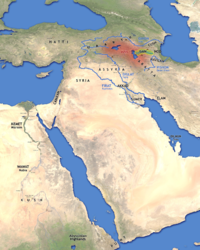
David Rohl suggests that the land of Eden was a vast area referred to in ancient Sumerian texts as the Edin (lit. "Plain", or "Steppe"), north of Mesopotamia beyond the Zagros mountains. The Garden of Eden was then located in a long valley 'in the east of Eden', to the north of Sahand volcano, near Tabriz. He cites several geographical similarities and toponyms which he believes match the Biblical description, including the four river headwaters of the Tigris (Hiddekel), Euphrates (Perath), Gaihun-Aras (Gihon) and Uizun (Pishon); the mountain range of Kusheh Dagh (the land of Cush); and Upper and Lower Noqdi (the land of Nod).[12] In his book From Eden to Exile: Unraveling Mysteries of the Bible, Eric H. Cline says "his suggestions have not caught on with the scholarly establishment. His argument is not helped by the fact that it depends upon speculations regarding the transmission of place-names for both the various rivers and nearby related areas from antiquity to the present. In the end, while Rohl’s suggestion is not out of the question, it seems no more probable than any other hypothesis, and less likely than those suggested by Speiser, Zarins, and Sauer."[13]
Jerusalem
Several religious traditions identify the location of the garden of Eden with the city of Jerusalem,[14] in particular Gihon Spring.[15]
Other Areas
Mòinteach Bharbhais
According to local folk-traditions in the Isle of Lewis, the Garden of Eden was located on the Barvas moor, just outside of the town. The area as it now appears is greatly altered from what it would have appeared as thousands of years ago, according to archaeological climate graphs, which appear to show a far milder and temperate atmosphere around the times of the Younger Dryas and the climactic amelioration after that.
Jackson County, Missouri, North America
For members of The Church of Jesus Christ of Latter-day Saints (also known as the Mormons or Latter Day Saints), the Garden of Eden is believed to have been located in present-day Jackson County, Missouri.[16] According to Mormon theology, Independence, Missouri, was revealed to be the "center place" of Zion and the original dwelling place of Adam and Eve in the Garden which God planted "eastward in Eden".[17][18] Mormons believe that Adam and Eve traveled 85 miles north to the valley of Adam-ondi-Ahman after they had transgressed and were driven from the Garden.[19] (Adam-ondi-Ahman is sometimes mistakenly associated with the location of the garden itself). As for its location in the western hemisphere, some Latter-day Saints have presumed the continents were not yet separate before the Great Flood[20] and that this approach would be consistent with the configuration of the super-continent Pangaea.[21]
In the footnotes of the Pearl of Great Price that are published by the church, it is stated that there were lands and rivers that were given names later attached to other lands and rivers as in the Book of Genesis.[22] The geographic descriptions of Eden in the Bible would therefore refer to entirely different lands and rivers than those carrying the same names today, whose names were transposed after the biblical flood to local lands and rivers in the Near East.
Adam's Peak, Sri Lanka
Adam's Peak, named after a footprint like formation found near the summit of a conical mountain. The Christian and Muslim tradition relates that this is the footprint of Adam and the possible location of Garden of Eden. Moreover there are four rivers starting from this mountain.
Interpretation
Eden as paradise
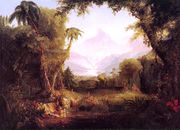
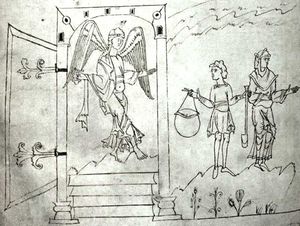
.jpg)
"Paradise" (Hebrew פרדס PaRDeS) used as a synonym for the Garden of Eden shares a number of characteristics with words for 'walled orchard garden' or 'enclosed hunting park' in Old Persian. The word "paradise" occurs three times in the Old Testament, but always in contexts other than a connection with Eden: in the Song of Solomon iv. 13: "Thy plants are an orchard of pomegranates, with pleasant fruits; camphire, with spikenard"; Ecclesiastes 2. 5: "I made me gardens and orchards, and I planted trees in them of all kind of fruits"; and in Nehemiah ii. 8: "And a letter unto Asaph the keeper of the king's orchard, that he may give me timber to make beams for the gates of the palace which appertained to the house, and for the wall of the city, and for the house that I shall enter into. And the king granted me, according to the good hand of my God upon me." In the Song of Solomon, it is clearly "garden"; in the second and third examples "park". In the post-Exilic apocalyptic literature and in the Talmud, "paradise" gains its associations with the Garden of Eden and its heavenly prototype. In the New Testament, there is an association of "paradise" with the realm of the blessed (as opposed to the realm of the cursed) among those who have already died, with literary Hellenistic influences observed by numerous scholars. The Greek Garden of the Hesperides was somewhat similar to the Christian concept of the Garden of Eden, and by the 16th century a larger intellectual association was made in the Cranach painting (see illustration at top). In this painting, only the action that takes place there identifies the setting as distinct from the Garden of the Hesperides, with its golden fruit.
Alan Millard has hypothesized that the Garden of Eden does not represent a 'geographical' place, but rather represents 'cultural memory' of "simpler times", when man lived off God's bounty (as "primitive" hunters and gatherers still do) as opposed to toiling at agriculture (being "civilized").[24] Of course there is much dispute between Judeo-Christian and secular scholars as to the plausibility of this idea - the refuting claim being that cultivation and agricultural work were present both before and after the "Garden Life".
The Second Book of Enoch, of late but uncertain date, states that both Paradise and Hell are accommodated in the third sphere of heaven, Shehaqim, with Hell being located simply " on the northern side:" see Seven Heavens.
In Jewish Eschatology
In the rabbinic literatures of the Talmud and the Jewish Kabbalah[25], the scholars agree that there are two types of spiritual places called Garden in Eden. The first is rather terrestrial, of abundant fertility and luxuriant vegetation, known as the "lower Gan Eden". The latter is envisioned as being celestial, the habitation of righteous, Jewish and non-Jewish, immortal souls, known as the "higher Gan Eden". The Rabbanim differentiate between Gan and Eden. Adam is said to have dwelt only in the Gan. Whereas Eden is said to never been witnessed by any mortal eye.[26]
According to Jewish Eschatology[27][28], the "higher Gan Eden" is called the "Garden of Righteousness". It has been created since the beginning of the world, and will appear gloriously at the end of time. The righteous dwelling there will enjoy the sight of the heavenly Chayot carrying the throne of God. Each of the righteous will walk with God, who will lead them in a dance. Its Jewish and non-Jewish inhabitants are "clothed with garments of light and eternal life, and eat of the tree of life" (Enoch 58,3) near to God and His anointed ones.[26] This Jewish rabbinical concept of a "higher Gan Eden" is opposed by the Hebrew terms Gehinnom[29] and Sheol, figurative names for the place of spiritual purification for the wicked dead in Judaism, a place envisioned as being at the greatest possible distance from "heaven".[30]
In art
Garden of Eden motifs most frequently portrayed in illuminated manuscripts and paintings are the "Sleep of Adam" ("Creation of Eve"), the "Temptation of Eve" by the Serpent, the "Fall of Man" where Adam takes the fruit, and the "Expulsion". The idyll of "Naming Day in Eden" was less often depicted. Much of Milton's Paradise Lost occurs in the Garden of Eden. Michelangelo depicted a scene at the Garden of Eden in the Sistine Chapel ceiling.
See also
- Antediluvian
- Antelapsarianism
- Christian naturism
- Fall of Man
- Fertile Crescent
- Jannah
- Original sin
- Persian gardens
- Serpent (Bible)
- Seth in the Garden of Eden
- Tamoanchan
- Utopia
References
- ↑ http://www.studylight.org/lex/heb/view.cgi?number=05730
- ↑ "Kush" is often incorrectly translated as Ethiopia, which was also known as Cush, but in this case thought to be referring to Cossaea which, unlike Ethiopia, does lie within the region being described. See E. A. Speiser, The Rivers of Paradise, reprinted in R. S. Hess & D. T. Tsumura (eds.), I Studied Inscriptions from Before the Flood, Eisenbrauns, 1994.
- ↑ See p. 200 n. 31 Curtius, Ernst Robert; Willard R. Trask (trans.) (1953/1990). European Literature and the Latin Middle Ages. Princeton UP. ISBN 9780691018997.
- ↑ Ronald F. Youngblood, F. F. Bruce, R. K. Harrison and Thomas Nelson Publishers, Nelson's New Illustrated Bible Dictionary, Rev. Ed. of: Nelson's Illustrated Bible Dictionary.; Includes Index. (Nashville: T. Nelson, 1995).
- ↑ D. R. W. Wood, New Bible Dictionary (InterVarsity Press, 1996, c1982, c1962), 289
- ↑ Speiser, Ephraim Avigdor (1964), "Genesis: Introduction, Translation and Notes" (The Anchor Bible). New York: Doubleday
- ↑ Zarins, Juris (1992), "The Early Settlement of Southern Mesopotamia: A Review of Recent Historical, Geological, and Archaeological Research" (Journal of the American Oriental Society, 1992)
- ↑ Sanford, W (2006), "Thoughts on Eden, the Flood, and the Persian Gulf" (Annual Meeting of the American Geological Society, 2006)
- ↑ Hamblin, Dora Jane "Has the Garden of Eden been located at last?" (Smithsonian) http://ldolphin.org/eden/
- ↑ Landsberger, Benno (1974), "Three essays on the Sumerians" (Undena Publications)
- ↑ C.A. Schlabach at Focus Magazine
- ↑ Rohl, David: Legend: The Genesis of Civilisation (Century, London, 1998).
- ↑ Cline, Eric H. (2007). From Eden to Exile: Unraveling Mysteries of the Bible. National Geographic. p. 10. ISBN 978-1426200847.
- ↑ For example, Aryeh Kaplan, Jerusalem Eye of the Universe. Union of Orthodox Jewish Congregations of America. (1993). ISBN 1-879016-12-5.
- ↑ Freedman, David Noel; Allen C. Myers; Astrid B. Beck Eerdmans Dictionary of the Bible Wm. B. Eerdmans, 2000. ISBN 978-0-8028-2400-4. p.371 [1]
- ↑ Bruce A. Van Orden, “I Have a Question: What do we know about the location of the Garden of Eden?”, Ensign, Jan. 1994, 54–55;
see also:
Andrew Jenson, Historical Record, 7:438-39 (1888);
Orson F. Whitney, Life of Heber C. Kimball, Salt Lake City: Bookcraft, 219 (1967);
Joseph Fielding Smith, Bruce R. McConkie (ed.) Doctrines of Salvation, Salt Lake City: Bookcraft, 3:74 (1954-56);
Heber C. Kimball, "Advancement of the Saints", Journal of Discourses 10:235 (1863);
Journal History of the Church of Jesus Christ of Latter-day Saints, Brigham Young to Orson Hyde, March 15, 1857 (1830- );
Wilford Woodruff, Susan Staker (ed.), Waiting for the World to End: The Diaries of Wilford Woodruff, Salt Lake City: Signature Books, 305 (1993);
John A. Widtsoe, G. Homer Durham (ed.), Evidences and Reconciliations, 396-397 (1960) - ↑ Doctrine & Covenants 57:1-3; Bruce R. McConkie, Mormon Doctrine, Salt Lake City: Bookcraft, 19-20
- ↑ Moses 3:8
- ↑ Deseret News, 10-25, 1895 (Letter Benjamin F. Johnson)
- ↑ See, e.g., Mark E. Petersen, Noah and the Flood, 78
- ↑ Frank B. Salisbury, The Creation, Salt Lake City: Deseret Book, 176 (1976).
- ↑ Moses 3:10-14.
- ↑ Gibson, Walter S. Hieronymus Bosch. New York: Thames and Hudson, 1973. p. 26. ISBN 0-500-20134-X
- ↑ A. R. Millard (January 1984). "The Etymology of Eden". Vetus Testamentum 34 (1): 103–106. doi:10.1163/156853384X00133.
- ↑ Gan Eden - JewishEncyclopedia; 02-22-2010.
- ↑ 26.0 26.1 ibidem.
- ↑ Olam Ha-Ba - The Afterlife - JewFAQ.org; 02-22-2010.
- ↑ Eshatology - JewishEncyclopedia; 02-22-2010.
- ↑ "Gehinnom is the Hebrew name; Gehenna is Yiddish." Gehinnom - Judaism 101 websourced 02-10-2010.
- ↑ Gan Eden and Gehinnom
External links
- Smithsonian article on the geography of the Tigris-Euphrates region
- Many translations of II Kings 19:12
|
|||||||||||||||||||||||||||||||||||||||||||||||||||||